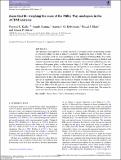Files in this item
Jeans that fit : weighing the mass of the Milky Way analogues in the ΛCDM universe
Item metadata
| dc.contributor.author | Kafle, Prajwal R. | |
| dc.contributor.author | Sharma, Sanjib | |
| dc.contributor.author | Robotham, Aaron S. G. | |
| dc.contributor.author | Elahi, Pascal J. | |
| dc.contributor.author | Driver, Simon P. | |
| dc.date.accessioned | 2018-03-16T15:30:07Z | |
| dc.date.available | 2018-03-16T15:30:07Z | |
| dc.date.issued | 2018-04-21 | |
| dc.identifier | 252572120 | |
| dc.identifier | 1cd60ce7-3ab0-4b74-8dce-d3edd05a7b5b | |
| dc.identifier | 85046141537 | |
| dc.identifier.citation | Kafle , P R , Sharma , S , Robotham , A S G , Elahi , P J & Driver , S P 2018 , ' Jeans that fit : weighing the mass of the Milky Way analogues in the ΛCDM universe ' , Monthly Notices of the Royal Astronomical Society , vol. 475 , no. 4 , pp. 4434-4449 . https://doi.org/10.1093/mnras/sty118 | en |
| dc.identifier.issn | 0035-8711 | |
| dc.identifier.other | ArXiv: http://arxiv.org/abs/1801.03950v2 | |
| dc.identifier.uri | https://hdl.handle.net/10023/12962 | |
| dc.description.abstract | The spherical Jeans equation is a widely used tool for dynamical study of gravitating systems in astronomy. Here, we test its efficacy in robustly weighing the mass of Milky Way analogues, given they need not be in equilibrium or even spherical. Utilizing Milky Way stellar haloes simulated in accordance with Λ cold dark matter (ΛCDM) cosmology by Bullock and Johnston and analysing them under the Jeans formalism, we recover the underlying mass distribution of the parent galaxy, within distance r/kpc ∈ [10, 100], with a bias of ∼ 12 per cent and a dispersion of ∼ 14 per cent. Additionally, the mass profiles of triaxial dark matter haloes taken from the surfs simulation, within scaled radius 0.2 < r/rmax < 3, are measured with a bias of ∼ − 2.4 per cent and a dispersion of ∼ 10 per cent. The obtained dispersion is not because of Poisson noise due to small particle numbers as it is twice the later. We interpret the dispersion to be due to the inherent nature of the ΛCDM haloes, for example being aspherical and out-of-equilibrium. Hence, the dispersion obtained for stellar haloes sets a limit of about 12 per cent (after adjusting for random uncertainty) on the accuracy with which the mass profiles of the Milky Way-like galaxies can be reconstructed using the spherical Jeans equation. This limit is independent of the quantity and quality of the observational data. The reason for a non-zero bias is not clear, hence its interpretation is not obvious at this stage. | |
| dc.format.extent | 3253018 | |
| dc.language.iso | eng | |
| dc.relation.ispartof | Monthly Notices of the Royal Astronomical Society | en |
| dc.subject | Galaxy: halo | en |
| dc.subject | Galaxy: kinematics and dynamics | en |
| dc.subject | QB Astronomy | en |
| dc.subject | QC Physics | en |
| dc.subject | 3rd-NDAS | en |
| dc.subject.lcc | QB | en |
| dc.subject.lcc | QC | en |
| dc.title | Jeans that fit : weighing the mass of the Milky Way analogues in the ΛCDM universe | en |
| dc.type | Journal article | en |
| dc.contributor.institution | University of St Andrews. School of Physics and Astronomy | en |
| dc.identifier.doi | https://doi.org/10.1093/mnras/sty118 | |
| dc.description.status | Peer reviewed | en |
This item appears in the following Collection(s)
Items in the St Andrews Research Repository are protected by copyright, with all rights reserved, unless otherwise indicated.

